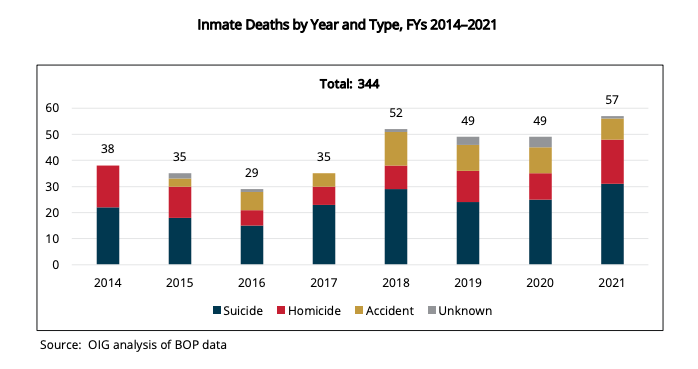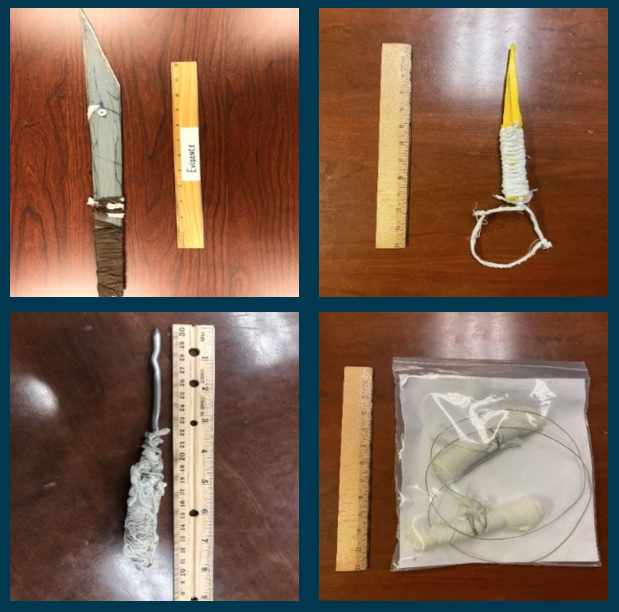Watchdog issues blistering report on hundreds of federal inmate deaths
Washington — Extreme staffing shortages, policy violations and systemic operational failures contributed to hundreds of likely preventable inmate deaths across the Federal Bureau of Prisons system between 2014 and 2021, a government watchdog found in a blistering report released Thursday.
The Justice Department's Office of the Inspector General examined 344 deaths of inmates in BOP's custody over the eight-year period that were the result of suicides, homicides or accidents. Health care-related deaths were excluded from the analysis.
More than half of the deaths — 187, or 54% — were by suicide, which the report said represents a "significant risk area" for the federal prison system. Homicide was the second most common cause of death.
Investigators found that some "recurring factors" in the population that died by suicide included their status as sex offenders, the length of their sentences and mental health struggles, correlations that could have served as warning signs to prison staff.
What the inspector general's report found
Failures to adequately screen for and monitor mental health issues, as well as deficiencies in caring for those identified as at-risk, likely contributed to the deaths by suicide. Notably, the vast majority of the deaths by suicide — 118 out of 187 — occurred among inmates who were deemed to have no mental health issues, highlighting the lack of accurate and consistent testing and treatment in the facilities.

In one instance described in Thursday's report, an inmate who attempted suicide prior to arriving at a BOP facility was housed alone in a single cell, and did not receive follow-up care for seven days. The individual later died by suicide. The inspector general said the case was emblematic of a wider trend identified by investigators: that inmates held in single cells were more likely to take their own lives.
According to the report, inmates "were able to advance their suicidal ideations and created increased opportunities for them to die by suicide" by going undetected and under-treated in a system that is plagued by communication breakdowns and violations of longstanding policies, like cell check-ins.
BOP staff are also required to conduct mock suicide drills to better respond to and prevent inmate deaths. An average of 72% of facilities lacked documentation showing they conducted the three required tests, although the report noted the rate slightly improved over time.
Improper documentation, short staffing and a failure to follow federal policy stood out as trends in the report. In about 30 of the 344 deaths, understaffing was identified by BOP as a factor. BOP personnel were unable to produce proper documentation related to 43% of the inmate deaths, the inspector general found.
During a 2022 visit to U.S. Penitentiary Thomson in Illinois, investigators said they were told the facility had not had an on-site, full-time physician on staff for more than a year. Nearly half of its nursing jobs were vacant.
The federal prison system — which houses roughly 157,000 inmates and is staffed by approximately 35,000 employees — has been plagued for years by staffing shortages and turnover. Inmates in BOP custody are most commonly incarcerated for immigration, drugs, firearms or white-collar crimes. The most violent offenders in the U.S. are typically held in state or local penitentiaries, since homicides and many violent crimes are not federally prosecuted. Nearly 93% of federal inmates are men.
Based on the inspector general's findings, prisons with higher security levels experienced a higher percentage of inmate deaths. The report found that 113 of the 187 suicides occurred in medium- or high-security facilities, and 59 of the 89 homicides happened in high-security prisons.
High-profile deaths
BOP has in recent years come under increased scrutiny following the deaths of several high-profile inmates in its custody. A 2023 inspector general report found that "numerous and serious" instances of staff misconduct allowed disgraced New York financier Jeffrey Epstein to kill himself. The 66-year-old financier was found dead in his New York cell in 2019, a little over a month after federal authorities took him into custody on charges of sex trafficking minors.
And in 2022, the Justice Department watchdog found that the prison death of notorious Boston mob boss James "Whitey" Bulger was the result of inadequate medical evaluations and intelligence gaps by BOP personnel. Three men were charged in his killing, which came less than 12 hours after he arrived at a West Virginia facility.
While high-profile in nature, the conditions that preceded those deaths were not unique to the federal prison system. Rather, they were emblematic of ongoing vulnerabilities highlighted in Thursday's report, the inspector general said.
Illegal contraband and drugs also greatly contributed to inmate deaths. According to investigators, nearly one-third of the 344 deaths involved drugs or weapons, like makeshift knives, razors or ropes. Seventy-nine inmates died from overdoses caused by either contraband drugs or the improper use of prescription medications.

The inspector general found that proper protocol was not followed in at least five drug overdose deaths in which the life-saving naloxone could have made a difference.
"Two BOP medical staff members we interviewed told us that they believe that, despite being trained in administering naloxone, Correctional Officers would wait for medical staff to arrive and administer naloxone because Correctional Officers were uncomfortable administering naloxone themselves," investigators wrote.
The inspector general noted that the COVID-19 pandemic affected inmates, and a lack of programming and socialization could have accounted for some of the increased deaths.
As is customary with inspector general reports, investigators recommended various steps BOP leadership should take to remedy the dismal findings. Those recommendations included developing strategies to improve health care designations of inmates; ensuring all staff are trained on defibrillator use and other life-saving practices; and improving documentation when deaths do occur.
In a letter to Inspector General Michael Horowitz, BOP Director Collette Peters concurred with the recommendations. In a statement issued Thursday, a bureau spokesperson said, "The FBOP has already taken substantial steps, as outlined in the OIG's report, to mitigate [inmate] deaths. Our priority is addressing the unique health challenges, including mental health, faced by individuals in custody, particularly those with a higher incidence of substance use disorders."
The statement continued: "We appreciate the thorough evaluation conducted by the OIG and acknowledge the tragic nature of unexpected deaths among those in our care."
If you or someone you know is in emotional distress or a suicidal crisis, you can reach the 988 Suicide & Crisis Lifeline by calling or texting 988. You can also chat with the 988 Suicide & Crisis Lifeline here.
For more information about mental health care resources and support, The National Alliance on Mental Illness (NAMI) HelpLine can be reached Monday through Friday, 10 a.m.–10 p.m. ET, at 1-800-950-NAMI (6264) or email info@nami.org.
Shooting after Kansas City Chiefs Super Bowl parade leaves one dead
Hamas commander on why terror group attacks civilians
Eyewitnesses describe scene at Kansas City Chiefs parade shooting

